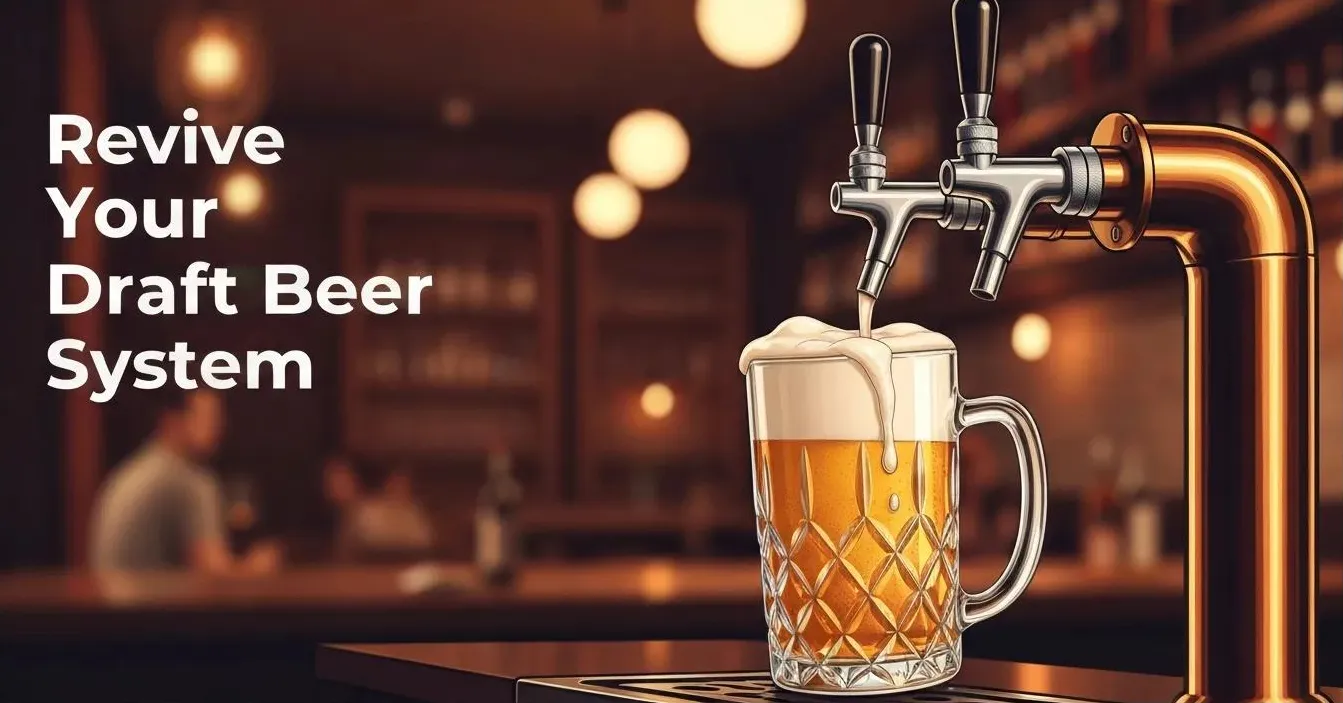How Often to Clean Kegerator Lines: Essential Maintenance Guide

Keeping your kegerator clean is crucial for maintaining the quality and taste of your beer. Beer lines should be cleaned every two weeks to prevent buildup and ensure the best flavor. If you want to maintain the quality of your draft beer, you should regularly clean my beer lines using specific solutions every two weeks, or after each keg change, and perform additional quarterly cleanings with different types of cleaners. Neglecting regular cleaning can lead to bacteria and mold, which can ruin your beer and even lead to health issues.
Cleaning the beer lines involves flushing them with a cleaning solution, disassembling and soaking parts like the faucet and keg coupler, and scrubbing away any debris. Regular maintenance not only improves taste but also extends the life of your equipment. For a detailed guide, you can follow these steps to clean kegerator beer lines at home.
Consistent cleaning also includes checking for damaged seals or gaskets, which should be replaced as needed. By following a regular cleaning schedule, you ensure you’re always pouring the freshest beer possible.

Key Takeaways
- Beer lines should be cleaned every two weeks
- Regular maintenance prevents bacteria and mold
- Replace damaged seals or gaskets as needed
The Importance of Regular Cleaning
Regular cleaning of kegerator lines is crucial to maintain the quality and taste of your beer. It's essential to clean your beer lines after each keg change to prevent bacteria, yeast, and mold buildup, which can cause flavors and contamination.
Understanding Beer Spoilage

Dirty beer lines can harbor bacteria, yeast, and mold. These microorganisms thrive in beer residue left in the lines. Bacteria can produce lactic acid, which imparts a sour taste, while yeast mutation can cause unexpected flavors. Mold growth can clog lines and lead to health risks. Regular cleaning prevents these issues, ensuring the beer tastes as intended. Proper maintenance of beer lines stops spoilage and keeps contamination at bay.
The Benefits of Maintaining Clean Lines
Clean beer lines provide several benefits. They ensure that your beer tastes fresh and free from off flavors. Regular cleaning removes sediment and buildup that can taint the beer. This upkeep is vital for both commercial and home kegerators to avoid health risks associated with mold or bacterial growth. Clean lines also extend the life of your kegerator system, making it a straightforward yet essential practice. Overall, clean lines mean better tasting beer and a more enjoyable experience. Removing beer residue through consistent cleaning is crucial for anyone serious about their draft beer quality. For detailed steps, you can refer to this guide.
Cleaning Frequency and Scheduling
Cleaning kegerator lines ensures the quality and taste of draft beer. The frequency of cleaning varies based on where the kegerator is used and other factors such as temperature and usage. It is crucial to tap beer lines regularly, ideally every two weeks, and sanitize them between each keg to maintain optimal performance.
Commercial vs Home Kegerators
Commercial kegerators with direct draw draft systems require more frequent cleaning due to higher usage. Bars and restaurants serve many kegs a week, making their beer lines prone to buildup. Cleaning every two weeks is recommended to keep the lines fresh and ensure the best quality of the draft beer.
Home kegerators, on the other hand, generally see less frequent use. Cleaning once a month is sufficient for homebrew setups. However, if switching between different kegs, cleaning each time you switch is wise. A beer line cleaning kit is essential for both home and commercial setups to maintain cleanliness.
Factors Affecting Cleaning Frequency
The type of beer and its ingredients can influence cleaning frequency. For instance, dark or hoppy beers may leave more residue in the lines. Temperature is another factor; warmer environments speed up bacteria growth, needing more frequent cleanings.
The usage volume plays a big role too. Higher usage means more frequent cleanings are necessary to prevent buildup. Cleaning kits make this task easier, ensuring that all parts of the system stay clean. Ensuring that kegerator lines and tap lines are clean and sanitized on a regular schedule will help maintain the best possible beer quality.
Choosing the Right Cleaning Agents and Equipment
Choosing the right cleaning agents and equipment is crucial for maintaining your kegerator. A mix of specialized tools and effective cleaning solutions will ensure your beer lines are free from build-ups and contaminants.
Necessary Tools for Effective Cleaning
To clean your kegerator lines, several tools are essential. Beer line cleaners are vital; they come in liquid or powder form and help remove beer stones and residues. Common options are caustic beer line cleaning solution for heavy-duty cleaning and acid-based beer line cleaner for mineral deposits.
A brush is necessary for scrubbing hard-to-reach places in the lines. Another tool is a faucet wrench, which helps disassemble taps for thorough cleaning.
You'll also need a sanitizer to disinfect the lines after cleaning. Some prefer PBW (Powdered Brewery Wash).
Cleaning kits often include all necessary items, making the job easier. These may come with a pressurized system to push the cleaning solution through the lines or a hand pump for manual application. Using the right tools can significantly impact the quality and taste of your draft beer.
Step-By-Step Cleaning Process
Cleaning kegerator lines involves disassembly, running the cleaning solution, and sanitizing the system. These steps ensure that no residue or buildup affects the taste and quality of the beer.
Disassembly and Reassembly of Components
Start by turning off the CO2 and unplugging the kegerator. Disconnect the coupler from the keg and unscrew it from the beer lines. Remove the faucet using a spanner wrench, then disassemble it.
Place all parts such as the faucet and keg coupler in a bowl with warm water mixed with beer line cleaner to soak. Use a faucet brush to clean any debris on the parts.
Rinse all parts thoroughly with clean water. Reassemble the faucet and reconnect it to the shank. Finally, attach the coupler back to the beer lines and the keg.
Circulating the Cleaning Solution
Prepare the cleaning solution according to the manufacturer’s instructions. Fill a cleaning pump or corny keg with the solution.
Attach the pump to the draft system and start circulating the solution through the beer lines using a hand pump or cleaning pump. Ensure all lines are filled with the solution to break down any residue or buildup inside.
Let the solution sit in the lines for 10-15 minutes. Afterward, pump the remaining cleaner out, ensuring no cleaning chemicals remain in the draft beer lines.
Rinsing and Sanitation Finish
Rinse the liquid lines with clean water to flush out any leftover cleaning solution. A bucket should be placed under the faucet to catch the rinse water. Continue rinsing until the water runs clear.
Use pH test strips to check the water for any remaining cleaning chemicals. The water should be neutral (pH 7).
Sanitize the liquid lines by running a sanitizing solution through them. Follow the manufacturer’s instructions for contact time. Once sanitized, rinse the system one last time with clean water.
Reassemble all components, turn the CO2 back on, and reconnect the keg. The draft system is now ready for use.
By thoroughly following these steps, you ensure the kegerator liquid lines remain clean, preventing any off-tastes in the beer.
Maintenance Between Cleanings
Proper maintenance of tap beer lines between deep cleanings helps extend the life of kegerator lines and ensures a high-quality pour. Regular maintenance can prevent problems like beer stone buildup and gunk.
After-Use Care
After each use, it is important to flush the lines with hot water. This helps remove any remaining beer and prevents the buildup of beer stones and other residues. A basic habit every homebrewer can adopt is to run hot water through the lines using a hand pump cleaning kit or gravity method.
Checking and replacing washers and rubber gaskets regularly can also prevent leaks and ensure a smooth pour. Make sure to use a spanner wrench to tighten or replace washers securely.
Regular inspection of the draft system components, like the tap faucet and keg coupler, should be done. Cleaning these parts with a simple solution of dish soap and warm water can remove any residue. Disconnecting the ball lifter and cleaning it will also keep your kegerator lines in top shape.
Detecting Early Signs of Beer Line Issues
Early detection of beer line issues can save time and money. If you notice excessive foaming or a change in taste, it may be time to check your lines for build-up. Foaming can be caused by dirty lines or clogged faucets.
Inspect the lines for signs of beer stone, which can appear as white or gray crystals inside the lines. Using a beer line cleaning solution occasionally can help clear out these deposits before they become problematic.
Ensure that all connections are tight and there are no leaks. It's wise to keep safety glasses on hand when inspecting and cleaning to protect your eyes from any splashes. Regular flushing, periodic checks, and keeping an eye on the quality of the pour can help maintain your home bar efficiently.
Summary
Cleaning kegerator lines is essential to ensure the best taste and quality of your beer. Regular maintenance prevents the buildup of debris and bacteria.
- Frequency: Ideally, kegerator lines should be cleaned every two weeks.
- Additional Cleaning: Clean the lines whenever switching kegs to avoid flavor contamination.
Steps:
- Flush and clean: Use a solution of warm water and line cleaner.
- Soak and scrub: Soak faucet parts and keg coupler; scrub with a brush if needed.
Following these guidelines helps maintain the quality and safety of your beer.



